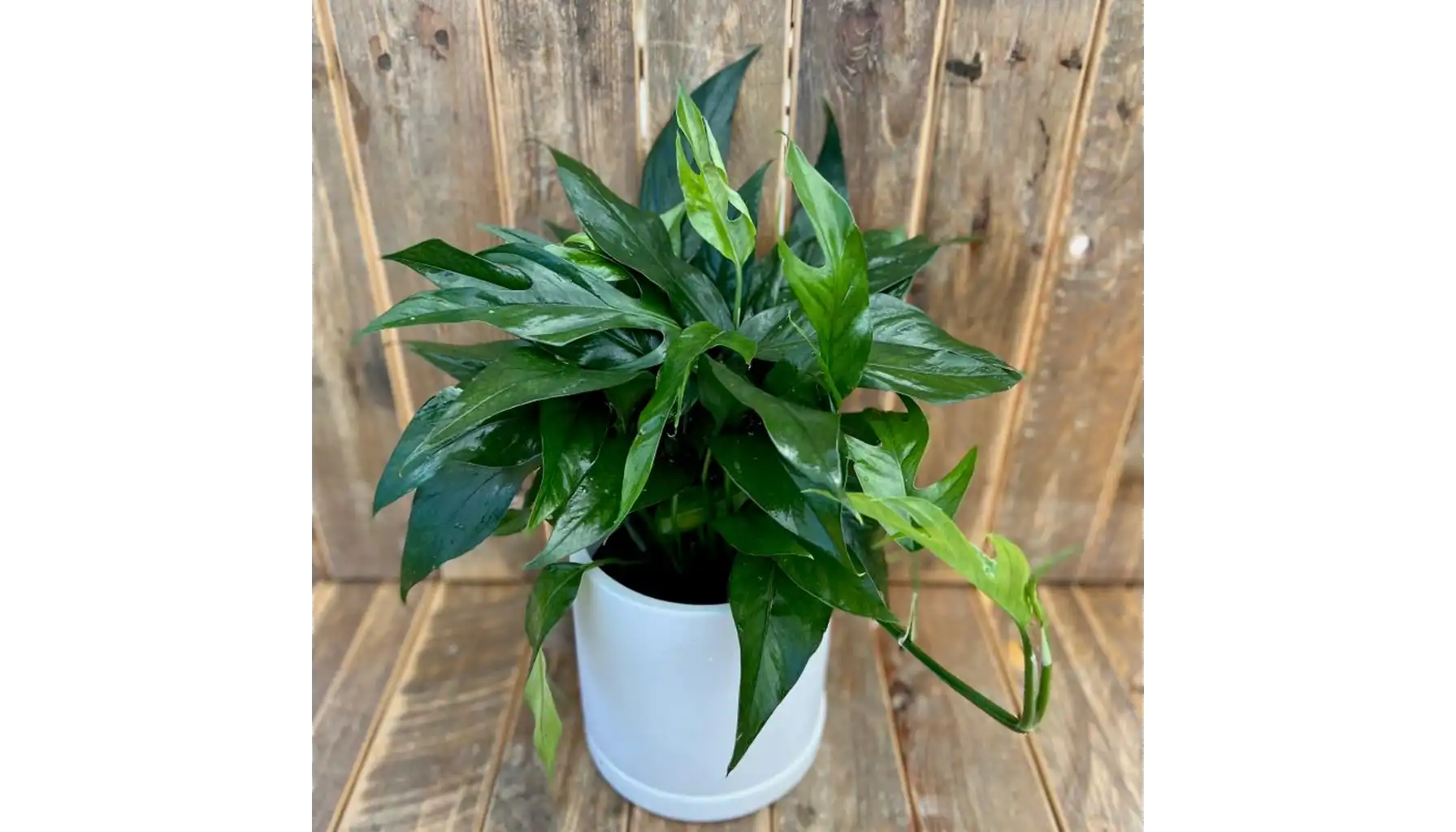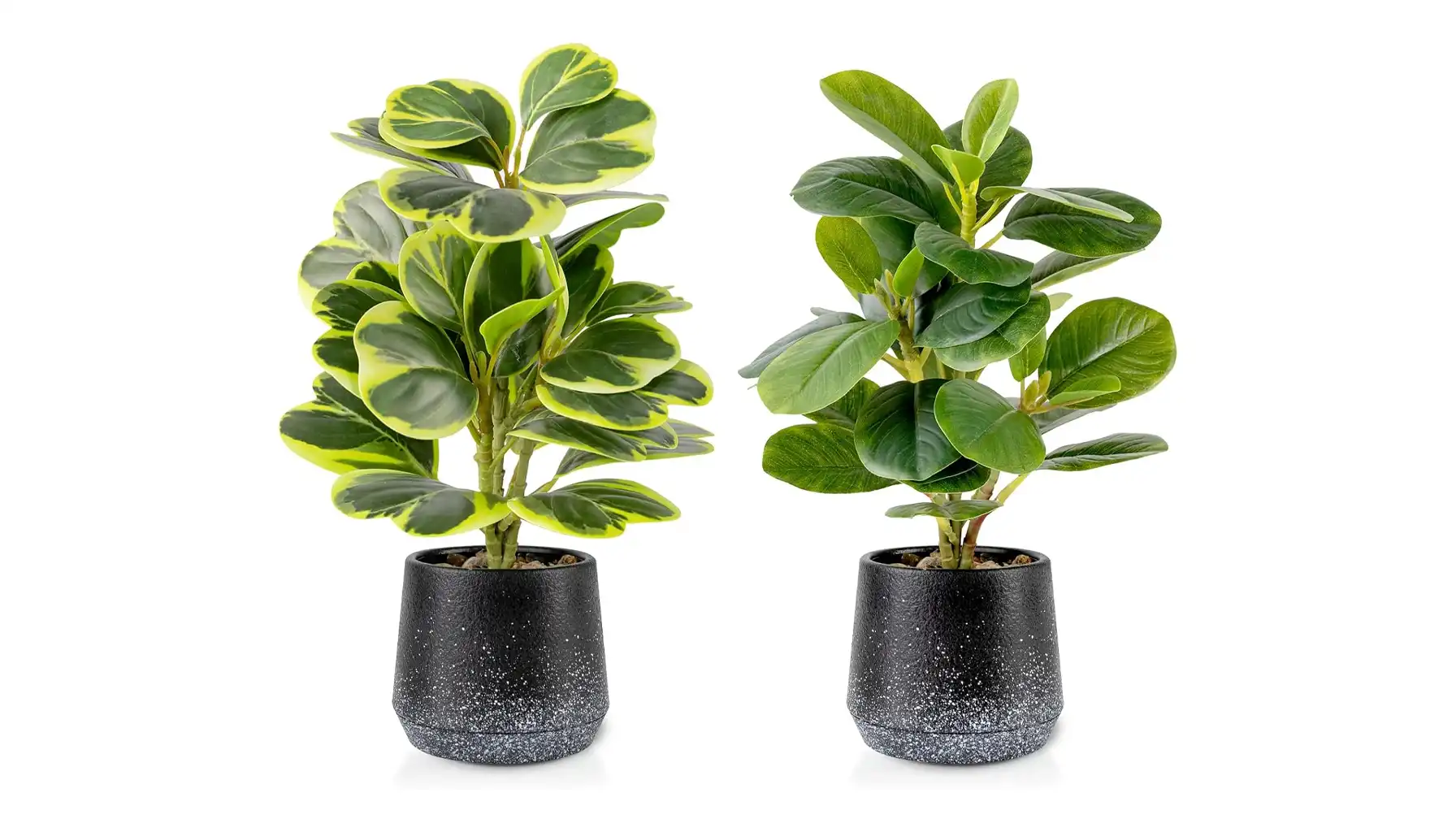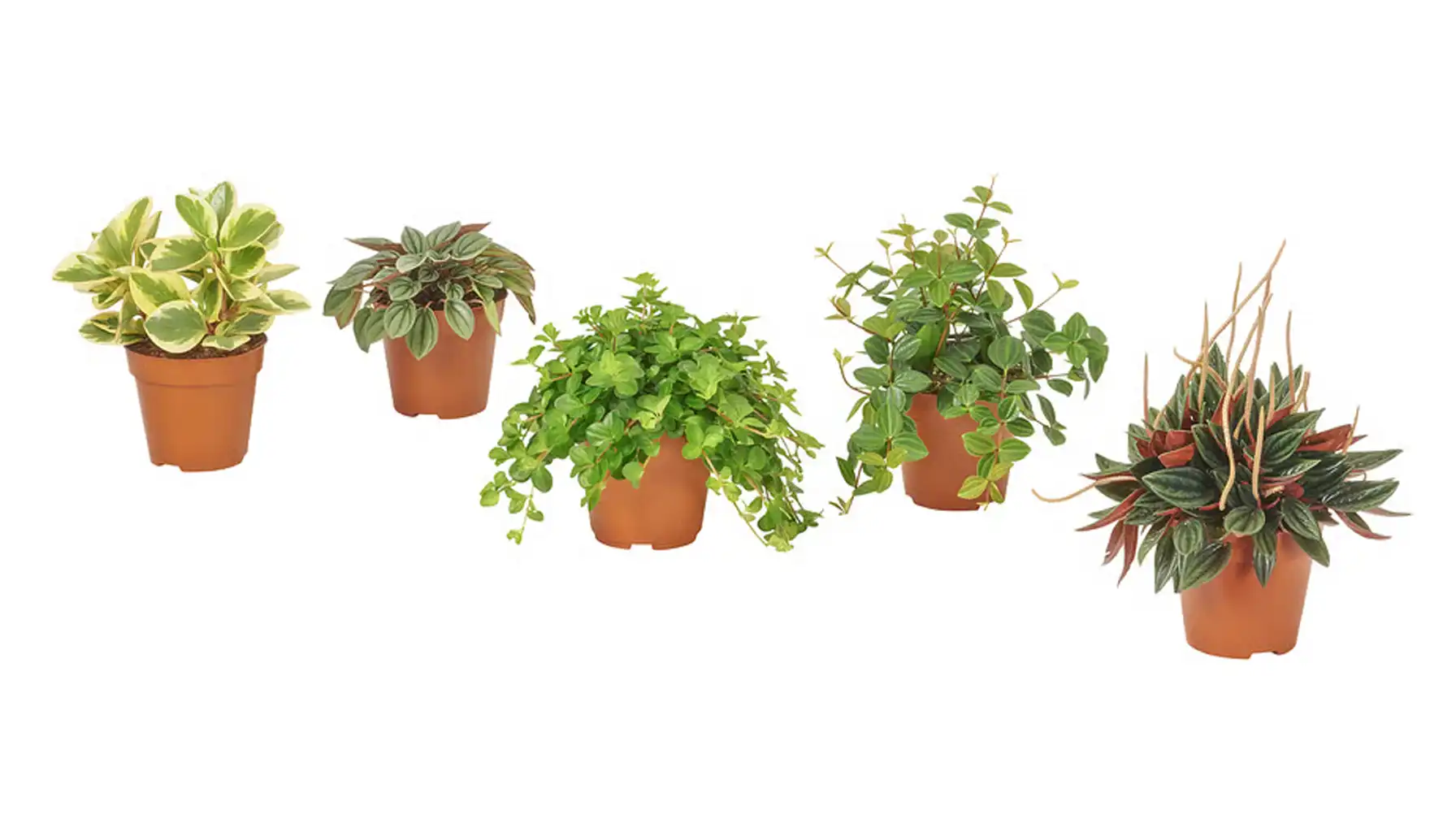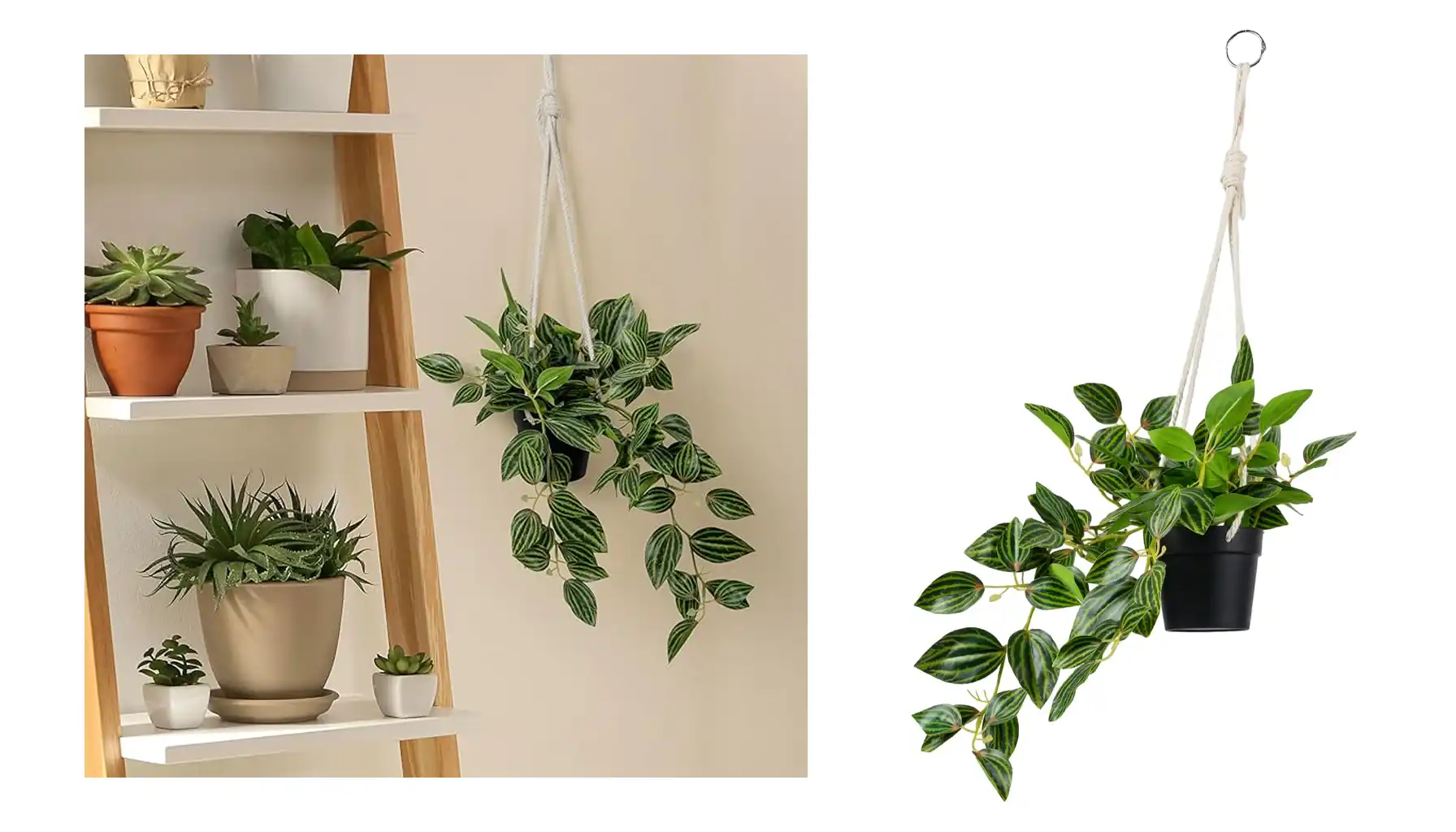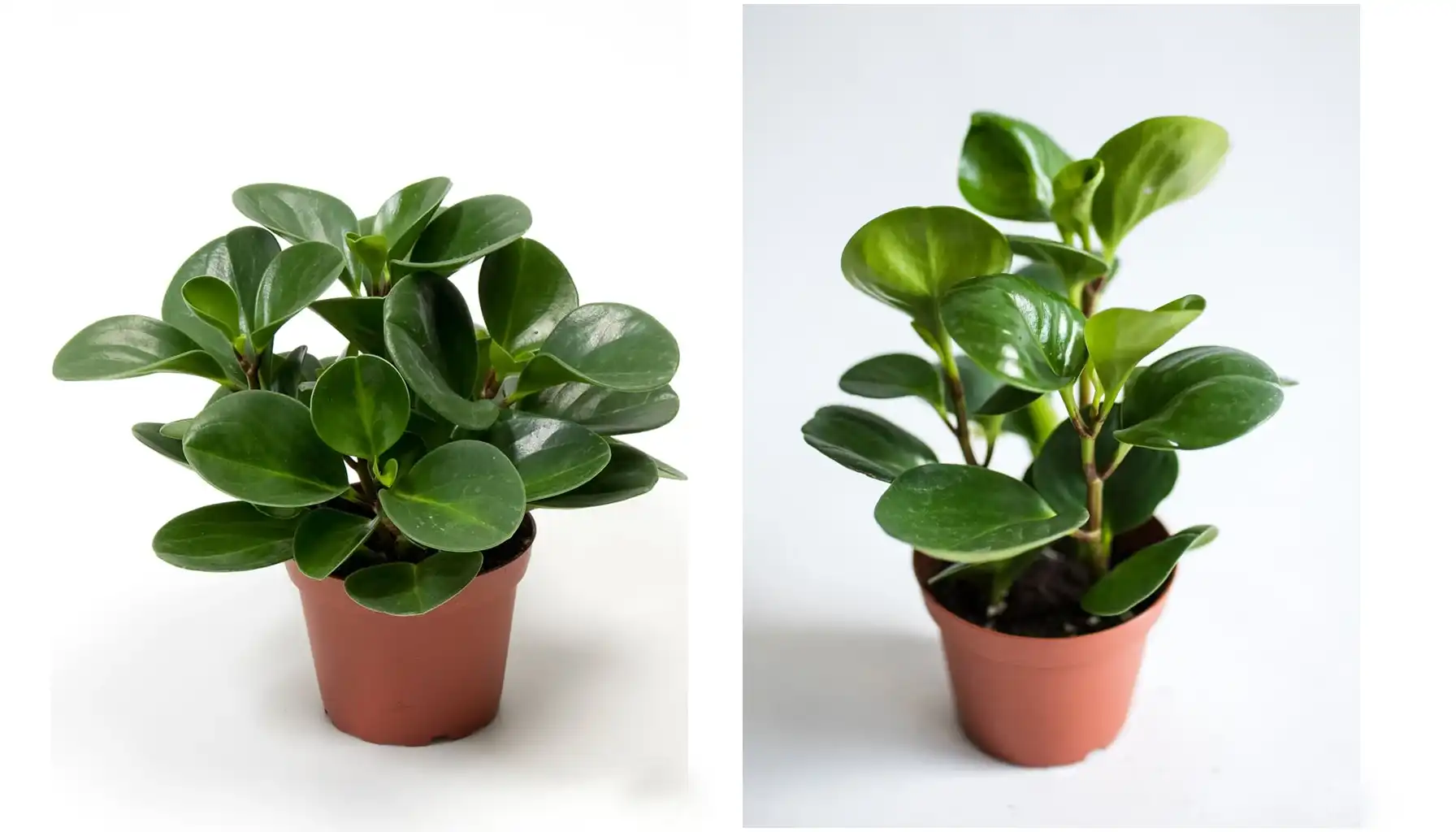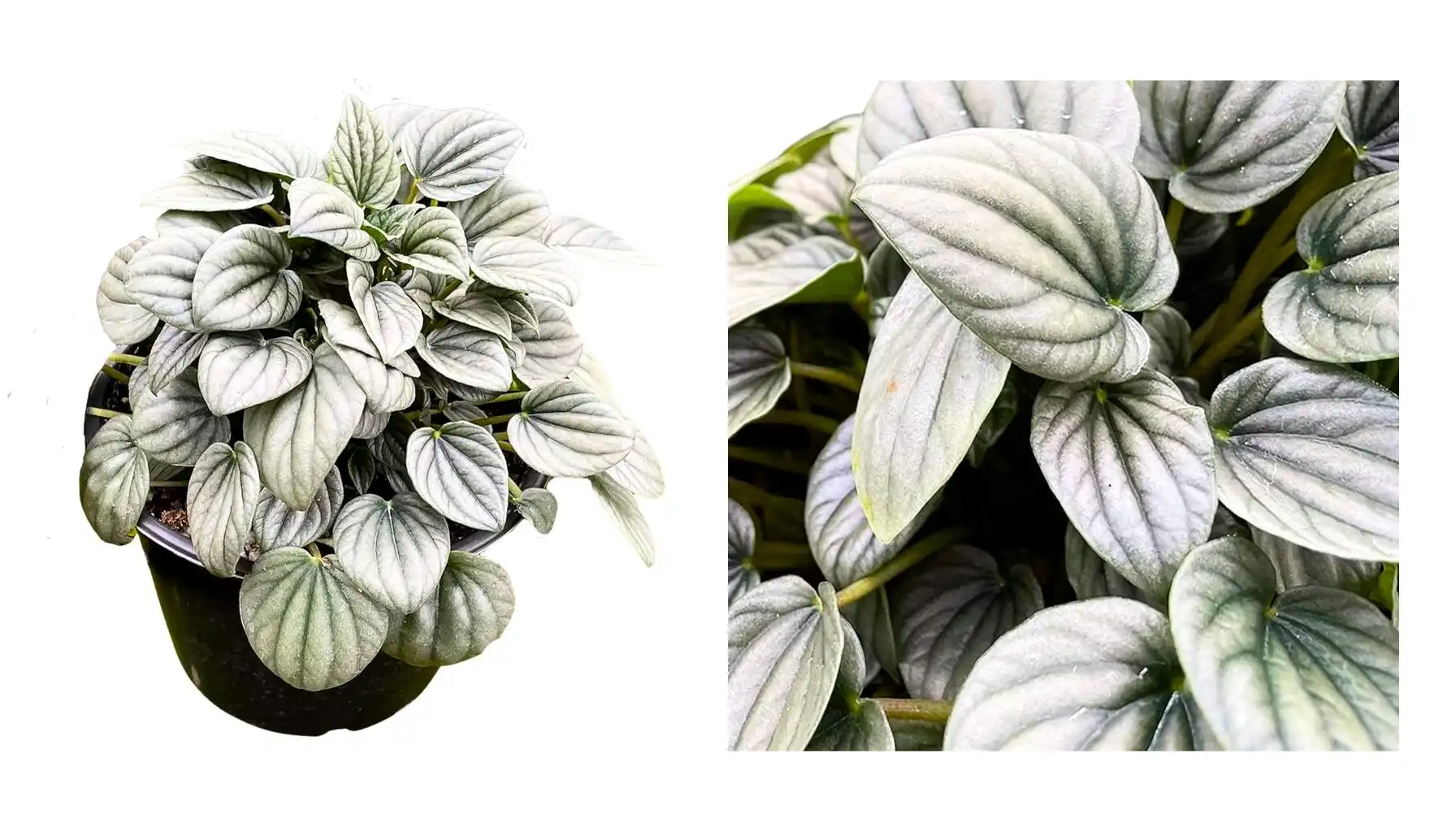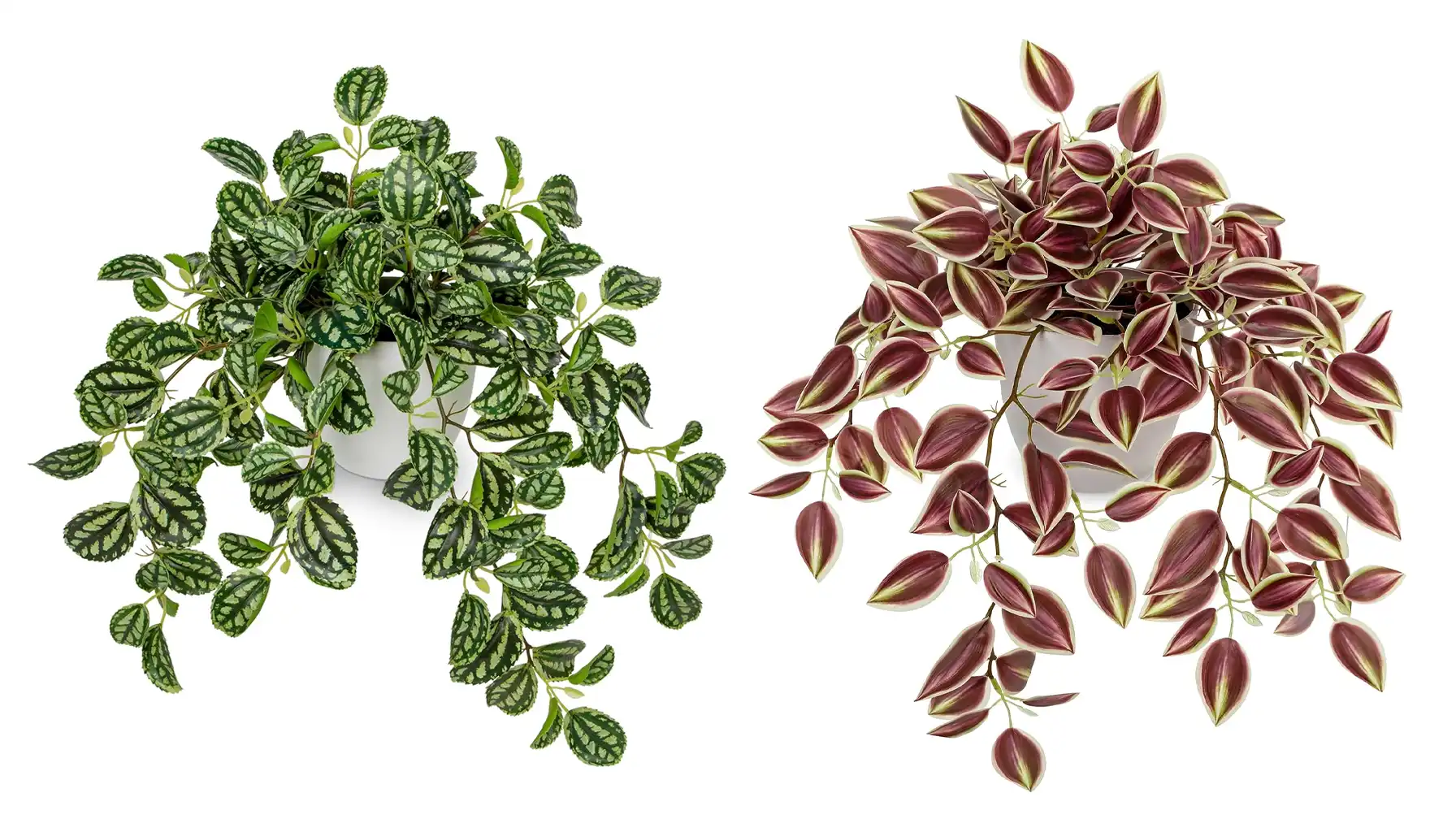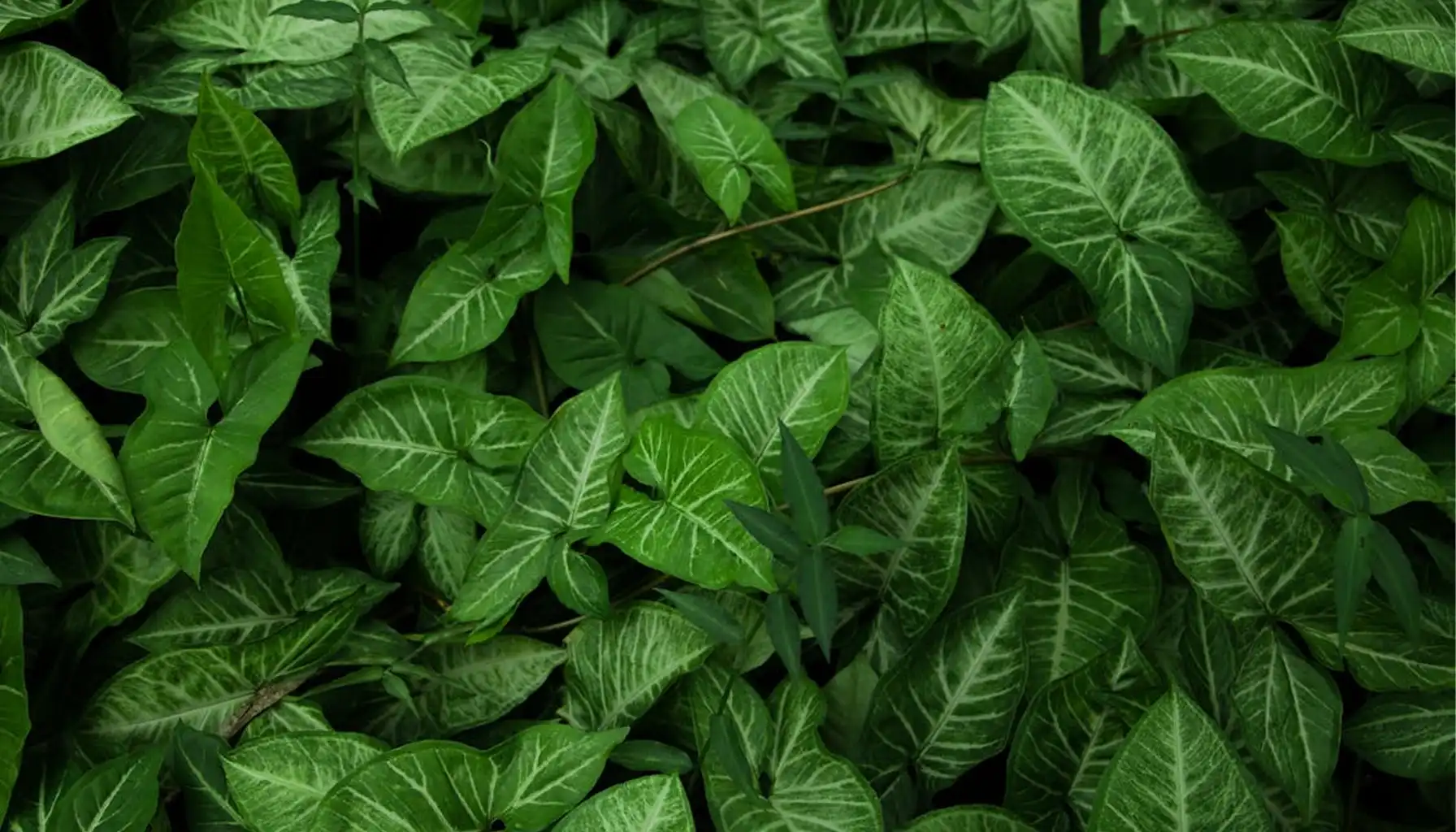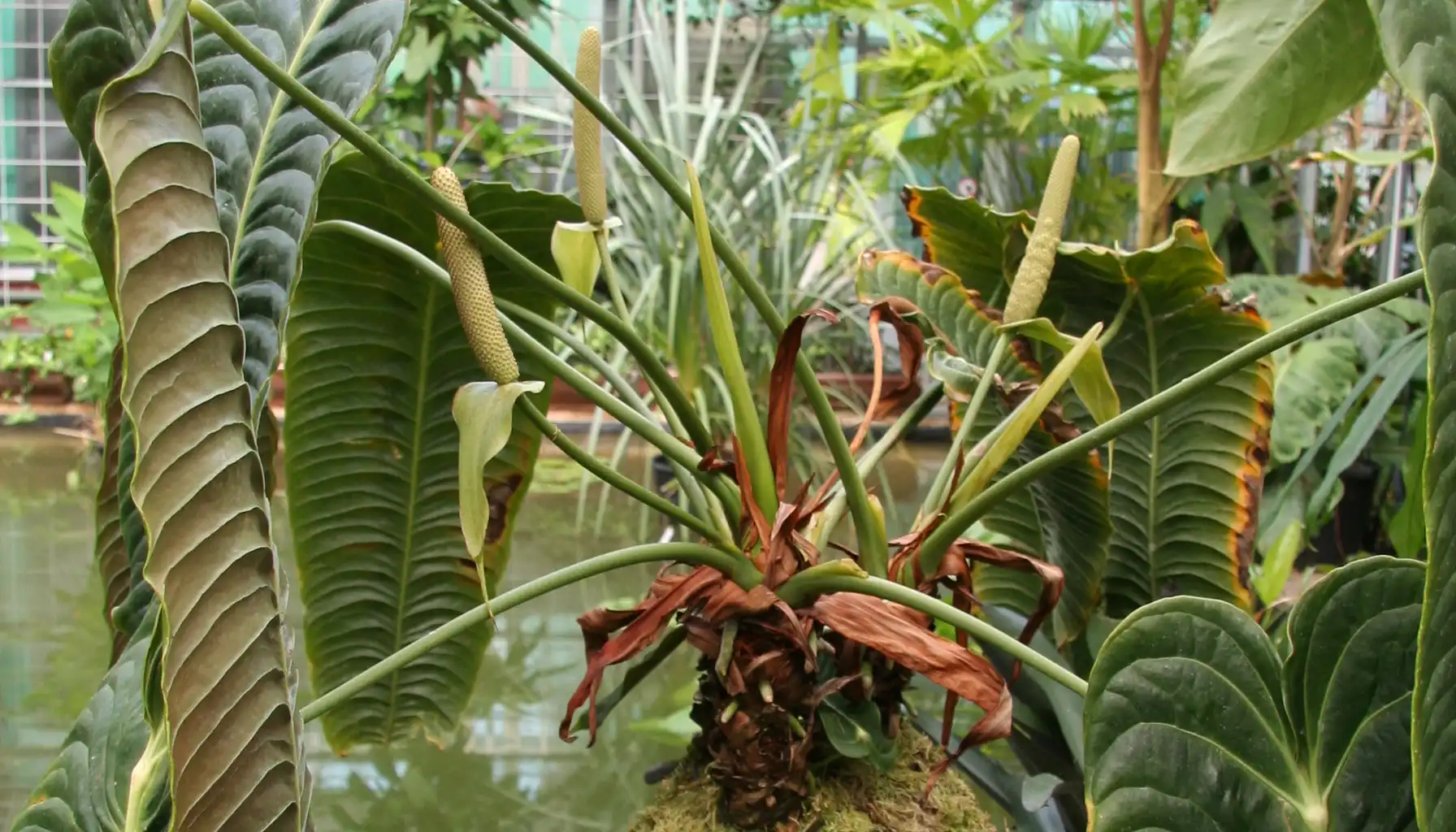Peperomia is a large genus of tropical and subtropical plants that belongs to the Piperaceae family. It’s a compact, easy-to-grow houseplants with ornamental foliage, different textures and colors and low-maintenance care.
You can identify a plant with an AI Plant Finder app! It will show you far more information about care and general details.
Botanical Name: Peperomia spp.
Family: Piperaceae (same family as black pepper)
Native Range: Central and South America, Caribbean, and parts of Asia
Growth Type: Small perennials—upright, trailing or bushy
Toxicity: Generally non-toxic to pets (cat- and dog-safe)
Here’s a Peperomia plant image with different types:
Peperomia Plant Types
Common Name | Botanical Name | Leaf Features | Growth Habit | Description |
Watermelon Peperomia Plant | Peperomia argyreia | Peperomia Watermelon plant has round leaves with silver and green stripes | Upright | Resembles watermelon rind; eye-catching foliage |
Peperomia Baby Rubber Plant | Peperomia obtusifolia plant | Thick, glossy green or variegated leaves | Upright, compact | Baby Rubber plant (Peperomia Obtusifolia) is semi-succulent |
Emerald Ripple | Peperomia caperata | Deeply textured, ruffled leaves (green, red, or silver) | Mounding | Popular for its dramatic texture |
String of Turtles | Peperomia prostrata | Small, round leaves with turtle shell pattern | Trailing | Ideal for hanging planters or terrariums |
Peperomia Hope Plant | Peperomia tetraphylla ‘Hope’ | Rounded, succulent leaves in whorls of 3–4 | Trailing/spreading | Hybrid; great for hanging baskets |
Red Edge | Peperomia clusiifolia | Thick green leaves with red or pink margins | Upright | Bold coloration; tolerates lower light |
Parallel Peperomia | Peperomia puteolata | Elongated green leaves with white stripes | Upright, bushy | Also called "Radiator Plant" |
Golden Gate | Peperomia obtusifolia ‘Golden Gate’ | Variegated cream, green, and yellow leaves | Upright, compact | Colorful variegation; easy care |
Cupid | Peperomia scandens | Heart-shaped, pale green leaves with creamy edges | Trailing | Also called “False Philodendron” |
Frost | Peperomia caperata ‘Frost’ | Silver-coated, wrinkled leaves | Compact | Striking metallic foliage. The Peperomia frost plant care is the same as other types |
Air Purifying Qualities
Peperomia indoor plant can help clean air by:
Absorbing VOCs (volatile organic compounds) like formaldehyde and benzene, especially through their leaves.
Reducing indoor humidity extremes slightly through transpiration.
Acting as dust filters, with their thick, waxy leaves trapping airborne particles.
Their compact size means the effect is limited compared to larger-leaved species like Pothos, but they still influence positively in small spaces like bedrooms or offices.
How to Care for a Peperomia Plant
Light
An indoor Peperomia plant likes bright, indirect light. It tolerates moderate light and some shade, but too little light may cause leaf color to fade or growth to slow. Avoid intense direct sunlight, which can scorch the leaves.
Watering
Let the top 1–2 inches of soil dry out between waterings. It stores water in its thick leaves, so it's better to underwater than overwater. Soggy soil leads to root rot.
Spring/Summer: Water every 7–10 days
Fall/Winter: Water less often, about every 14–20 days
Always use a pot with drainage holes.
By the way, here are perfect plants for the fall season.
Humidity & Temperature
It prefers average indoor humidity. Can tolerate dry air but appreciates occasional misting.
The best temperature is 18–26°C (65–80°F). Keep away from cold drafts and sudden temperature drops.
Soil
Use a light, well-draining soil mix for a Peperomia plant care. A blend of potting soil + perlite or orchid bark works well. Avoid heavy, moisture-retentive soils.
Fertilizer
Feed monthly during the growing season (spring and summer) with a diluted liquid houseplant fertilizer (¼ to ½ strength). Avoid fertilizing in winter.
Pruning & Maintenance
Remove dead or yellowing leaves to promote airflow.
Pinch the stems to encourage bushier growth.
Wipe the leaves occasionally to keep them clean and dust-free.
Repotting
These species prefer tight pots and don’t need frequent repotting. Repot every 2–3 years or when roots start circling the pot. Choose a pot just 1 size larger.
Propagation
The Peperomia plant propagation is easy:
Leaf cuttings (in water or soil)
Stem cuttings with at least one node
Best done in spring or early summer
Important! Is Peperomia plant safe for cats and dogs? It’s non-toxic to cats and dogs. So, it’s a pet-friendly choice.
Look at a Peperomia plant photo:
Peperomia Plant Benefits
1. Compact & Space-Saving
They stay small (typically under 12 inches). They are great for desks, shelves and apartments where space is limited.
2. Low Maintenance
These species are forgiving, drought-tolerant, and thrive in indirect light. Ideal for beginners or busy owners.
3. Pet-Friendly
Most species are non-toxic to cats and dogs.
4. Indoor Air Purifying
They can help filter minor toxins and improve indoor air quality by absorbing volatile organic compounds (VOCs).
5. Decorative Foliage
Available in many colors, shapes and textures—from rippled emeralds to striped silver and variegated cream.
6. Easy to Propagate
They propagate well from stem or leaf cuttings. So, it’s easy to expand your collection or share with friends.
Some Drawbacks
1. Sensitive to Overwatering
Because of their succulent-like leaves, they are prone to root rot if overwatered or grown in poorly draining soil.
2. Lower Tolerance for Deep Shade
While tolerant of lower light, they don’t thrive in very dark rooms—growth will slow and variegation may fade.
3. Pest Risk in Dry Air
In overly dry environments, they may attract spider mites, especially if humidity is too low and the plant is under stress.
4. Slow Growers
They’re not fast-growing, which can be a drawback if you’re looking for a quick-filling species.
5. Inconspicuous Blooms
Peperomia plant flowers exist, but their spike-like blooms are not visually impressive.
Beginner-Friendly Varieties You Can Buy Online
1. Baby Rubber
This semi-succulent has thick, glossy leaves that store water.
Light: Bright, indirect to moderate light
Watering: Every 10–14 days
Available as: Green or variegated ('Marble' and 'Golden Gate')
Ships well? Yes — sturdy and low-transpiration
2. Ripple
Its deeply textured, ruffled leaves are both unique and tough. Popular cultivars are ‘Rosso’ (with red undersides) and ‘Frost’ (silvery foliage).
Light: Medium to bright indirect
Watering: When topsoil dries
Popular for: Offices, desks, small containers
Ships well? Yes — compact and travel-tolerant
3. Watermelon Variety
Named for its striped foliage that resembles watermelon rinds, this variety is showy but surprisingly easy to manage indoors.
Light: Bright, filtered light
Watering: Weekly or when soil feels dry
Style: Upright rosette with round, bold leaves
Ships well? Moderate — slightly more delicate, ship in mild weather
Where to Buy These Online
Most of these varieties can be found at:
Look for sellers that offer safe packaging, heat packs in winter and live plant arrival guarantees.
FAQs
Do Peperomia plants flower?
Yes, they produce small, spike-like flowers known as inflorescences. These are usually thin, tail-like structures in white or pale green. While not showy, flowering signals a healthy, mature plant. That means that its owner knows how to care for Peperomia plant species.
Is it a good indoor plant?
Yes. It’s compact, low-maintenance, and thrives in indoor light. It fits well on desks, bookshelves, and window sills, and most varieties do not require high humidity.
What is a Rubber Plant Peperomia?
The Peperomia obtusifolia is commonly known as the Baby Rubber due to its thick, glossy leaves that resemble those of a Ficus elastica (the true rubber plant), though they are unrelated.
What is a Peperomia Marble plant?
Peperomia obtusifolia ‘Marble’ is a variegated cultivar with green leaves splashed with creamy white or yellow. It’s visually striking and just as easy to care for as the standard Baby Peperomia Rubber plant.
Can it be a Peperomia hanging plant?
Yes. Many types—like Hope, String of Turtles and scandens—are good for hanging baskets or trailing from shelves.
What is the Peperomia Money Plant?
While the name "money plant" is often used for Pilea peperomioides, some refer to Peperomia polybotrya ‘Raindrop’ as a money plant due to its coin-like leaves. It’s unrelated to the true money tree (Pachira aquatica).
What are some common Peperomia plant varieties?
Popular types include:
- argyreia (Watermelon)
- obtusifolia (Baby Rubber)
- caperata (Ripple)
- hope
prostrata (String of Turtles)
- polybotrya (Peperomia Raindrop plant)
Is Peperomia plant toxic to cats?
No. It’s non-toxic to cats and dogs, according to the ASPCA. Still, it’s best to keep them out of reach to prevent chewing or uprooting.
Related AI Plant Finder Posts
